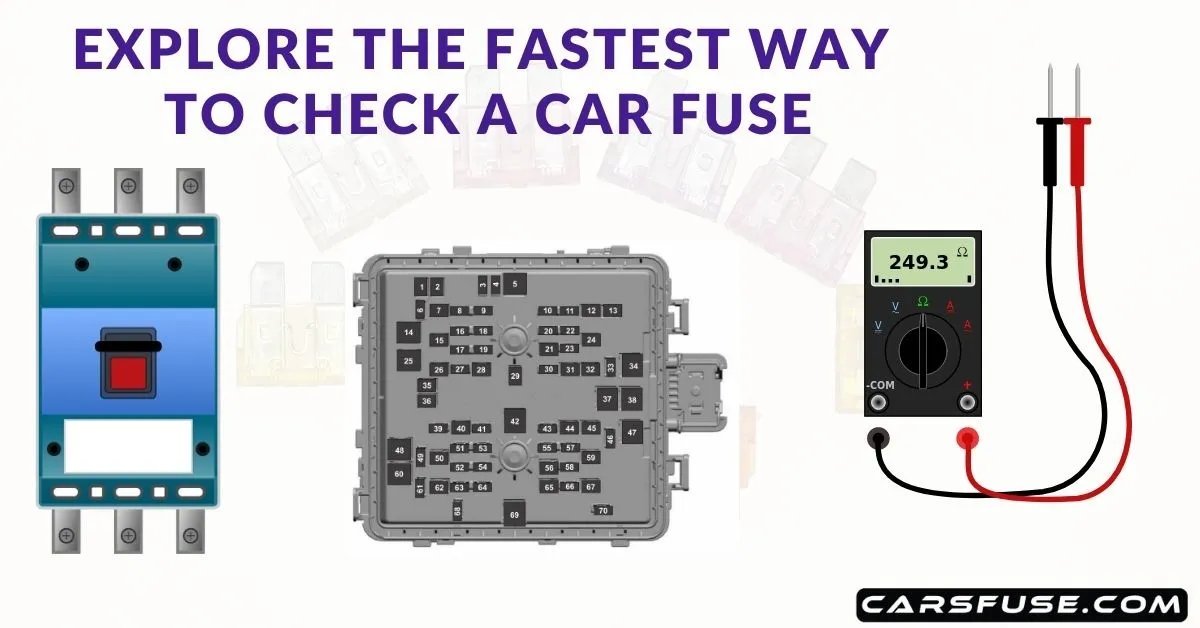Fuses in a vehicle play a crucial role in protecting electrical components from potential hazards. These small devices break the circuity during an overload or short circuit conditions.
Checking car fuses, and regularly maintaining them is crucial to ensure the safe operation of your car.
In this technical blog, we will find out what is the fastest way to check a car fuse, diagnose it, and resolve fuse-related issues.
Let’s start.
Table of Contents
Tools needed for checking car fuses
For checking car fuses, you need to have some important tools like a fuse puller, flashlight, multimeter (optional), spare fuses, and so on.
Fuse Puller: A fuse puller is a specialized tool designed to safely remove fuses from their sockets. It helps prevent damage to the fuse or the fuse box while removing or inserting fuses. Some fuse boxes may have a built-in fuse puller, while others may require a separate tool.
Multimeter (optional): A multimeter is a handy and accurate tool to check fuses. It is not that mandatory however, if you have one it can be used to measure the electrical voltage, resistance, and continuity of the fuses.
Flashlight: If the fuse box is located in a dark or hard-to-reach area, a small flashlight or a headlamp might be helpful in identifying, and inspecting the fuses.
Spare Fuses: Keeping spare fuses is a good practice when checking car fuses as you may find a blown fuse during the inspection.
Fastest Way to Check a Car Fuse
Following a systematic approach will help you quickly check a car fuse and identify any issues. Here is a step-by-step guide to efficiently inspect and test car fuses:
IMPORTANT NOTE: Always follow safety precautions before inspecting, and replacing fuses. Ensure the vehicle’s ignition is turned off to avoid any electrical accidents. Let the car engine cool down before proceeding to prevent any burns or injuries.
Locate the Fuse Box
You can read the owner’s manual of your vehicle to locate the fuse box, Normally, there are two fuse boxes in a vehicle: one in the engine compartment, and the other under the dashboard (interior section).
Access the Fuse Box
As you find the fuse box, you can open it, and the process depends on the vehicle model. Some vehicles require hands or a screwdriver to remove the fuse cover. Likewise, some fuse boxes may have clips or fasteners that need to be undone.
Analyze the Fuse Box Diagram
You can find a diagram for the fuse box, and its components in the owner’s manual. The fuse box diagram is very much handy in identifying and locating the required fuses.
For instance, if your power windows are not working, you can look at the diagram, and find out which fuse is responsible for handling the power windows. With that, you can start the inspection.
Inspection of the Fuse
The fastest way to check a car fuse is the visual inspection. You can examine the fuse for any signs of damage including blown-out appearance, discoloration, broken filament, and so on.
If you have a multimeter available, you can use it to check the continuity or resistance mode. For that, touch the multimeter probes to each end of the fuse.

If the multimeter shows continuity or a low resistance reading, the fuse is functioning correctly. If not, the fuse is likely blown and should be replaced.
You may need to replace the fuses if it is blown or faulty. Remember to replace the blown fuse with a new fuse of the same amperage rating.
After successful replacement, you can close the fuse box, and properly secure it.
Conclusion on ‘What is the fastest way to Check a Car Fuse?’
By following the fastest way to check a car fuse outlined in this guide, you can quickly diagnose and resolve fuse-related issues. Regularly inspecting fuses allows you to identify blown fuses and replace them promptly, ensuring the smooth functioning of various electrical components in your car.
It is important to emphasize the significance of referring to your car’s manual for specific instructions and fuse box locations. Additionally, taking necessary precautions, such as turning off the ignition and allowing the engine to cool down, ensures your safety during the process.
Remember to gather the required tools, including a fuse puller, flashlight, and multimeter if available, before starting the inspection. These tools will facilitate a faster and more efficient process.
In cases where a blown fuse is identified, promptly replacing it with a new fuse of the same rating will restore proper function to the corresponding electrical circuit.
.

